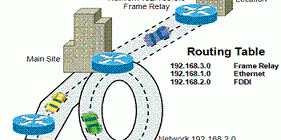Static Routing
Static routing knowledge is administered manually: a network administrator enters it into the router’s configuration. The administrator must manually update this static route entry whenever an internetwork topology change requires an update. Static knowledge is private—it is not conveyed to other routers as part of an update process. Static routing has several useful applications when it reflects a network administrator’s special knowledge about network topology.
When an internetwork partition is accessible by only one path, a static route to the partition can be sufficient. This type of partition is called a stub network. Configuring static routing to a stub network avoids the overhead of dynamic routing.
Dynamic Routing
After the network administrator enters configuration commands to start dynamic routing, route knowledge is updated automatically by a routing process whenever new topology information is received from the internetwork. Changes in dynamic knowledge are exchanged between routers as part of the update process. Dynamic routing tends to reveal everything known about an internetwork. For security reasons, it might be appropriate to conceal parts of an internetwork. Static routing allows an internetwork administrator to specify what is advertised about restricted partitions.
In the illustration above, the preferred path between routers A and C is through router D. If the path between Router A and Router D fails, dynamic routing determines an alternate path from A to C. According to the routing table generated by Router A, a packet can reach its destination over the preferred route through Router D. However, a second path to the destination is available by way of Router B. When Router A recognizes that the link to Router D is down, it adjusts its routing table, making the path through Router B the preferred path to the destination. The routers continue sending packets over this link. When the path between Routers A and D is restored to service, Router A can once again change its routing table to indicate a preference for the counterclockwise path through Routers D and C to the destination network.
Distance Vector versus Link State
Distance vector versus link state is another possible routing algorithm classification.
- – Link state algorithms (also known as shortest path first algorithms) flood routing information about its own link to all network nodes. The link-state (also called shortest path first) approach recreates the exact topology of the entire internetwork (or at least the partition in which the router is situated).
- – Distance vector algorithms send all or some portion of their routing table only to neighbors. The distance vector routing approach determines the direction (vector) and distance to any link in the internetwork.
- – A third classification in this course, called hybrid, combines aspects of these two basic algorithms.
There is no single best routing algorithm for all internetworks. Network administrators must weigh technical and non-technical aspects of their network to determine what’s best.

